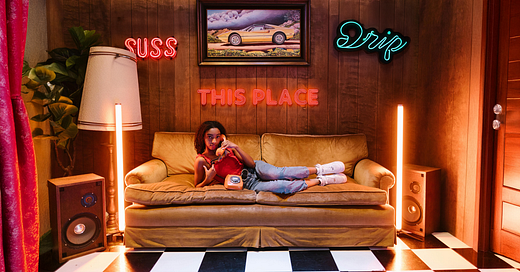Let’s start with a quick comprehension test. If these phrases make complete sense to you, congrats—you might be fluent. If not, welcome to the cultural gap you’re probably designing into:
“Delulu is the solulu.”
“She’s giving main character energy.”
“My Roman Empire is Stanley cups, actually.”
“Hard launch your situationship.”
To most Millennials or Boomers, this sounds like a fever dream. To Gen Z and Gen A, it’s just... Tuesday. And that matters—not because you need to speak their slang, but because you need to understand the systems that shape how they think, choose, and engage.
These generations aren’t just younger. They are built differently—technologically, behaviorally, socially, aesthetically. And they’re already deciding where to live, work, travel, and belong. If your buildings, brands, or experiences are still optimized for last decade’s funnel, you’re invisible.
Repeat after us: “I am not my customer, and my customer is not me.”
“I am not my customer, and my customer is not me.”
This should be every developer’s, designer’s, and brand builder’s mantra moving forward.
You don’t choose a building the way your customer does. You don’t research it the way they do. You don’t judge it by the same metrics. You probably don’t even know what Discord is really for, or why Gen Z treats their Notes app like a sacred text.
So if you’re designing spaces based on what you would want, you’re likely missing the mark. The real customer lives in a different mental operating system entirely.
Let’s break down just how far apart these worlds are.
1. Their consumption journey is fragmented, fast, and emotionally driven
Buying used to follow a linear logic: awareness → interest → research → decision. For Gen Z, that flow looks more like a web of tabs, texts, DMs, screen recordings, vibe checks, memes, and micro-moments.
A decision to lease, book, or buy is now shaped by:
A TikTok apartment tour from someone they don’t follow
A friend’s offhand “ugh that building is lowkey cursed”
A Reddit thread called “is this place actually nice or just Instagram nice?”
The Google Maps photos from two years ago
A Reel titled “Places That Would Totally Pass a Turing Test”
You could have the best floor plans, the best rates, the best location—and still be skipped over because your digital footprint reads as “weirdly thirsty” or “tryhard” or “IDK, feels like my parents would live there.”
Perception precedes product. Always.
2. They engage with brands like cultural identities and flee from brands on a dime
This generation doesn’t want your pitch. They want your personality.
They look for signals: Are you self-aware? Are you fluent in their aesthetics, humor, and values? Are you behaving like a brand—or like a person worth knowing?
They also cancel fast. Remember when Crocs were canceled and then re-adopted ironically and now sit in the top-tier rotation of fashion collabs? That’s the level of emotional elasticity we’re dealing with.
If your brand voice sounds like it came from a hotel manual—or your interiors feel like they were specced from a Pinterest board circa 2016—you’re already background noise.
3. They don’t live in silos, so your space shouldn’t either
Here’s how Gen Z and Gen A are blending categories:
Working while traveling is just “being online in Lisbon.”
Living with roommates at 28 is financially strategic and socially preferred.
Using public spaces (hotel lobbies, co-working lounges, train station cafés) as their office is the norm.
Hotels, apartments and retail spaces double as content backdrops.
The idea of a space doing one thing well is almost laughable. If it doesn’t photograph well, offer flexible zones, and carry the energy of a curated playlist, it’s not cutting it.
What to do about it
Design for influence, not just impact
You’re not just designing a space to be used. You’re designing a space to be shared. Every wall, fixture, view, and graphic should assume it will be photographed and interpreted. Ask yourself: what will end up on camera? What will travel?
Build brand fluency into your ops
From confirmation emails to building signage to staff interactions, every element should feel coherent—not like a template or afterthought. If your tone doesn’t match your design, people will notice. Especially this generation.
Make your brand remixable
This isn’t about UGC. It’s about cultural permeability. Does your space have slogans that become memes? Stickers worth putting on a Hydro Flask? A lobby worth screen-shotting?
Go native in your digital ecosystem
Don’t just “do social.” Live in the places your customers do—Discord, Substack, TikTok. Not as an ad, but as a human personality.
Treat your onboarding like a cool product
First impressions are everything. Ditch the high gloss leasing packet. Build a cinematic move-in experience. Deliver it like Apple packaging. Make it fun to show off.
Feeling old? Just wait...
Here’s what the new customer journey looks like:
They’ll find you via an untagged photo in someone’s camera roll.
They’ll vet you through a Google review written like a fanfic.
They’ll browse your spaces in 0.5x speed while screen recording and texting it to three friends.
They’ll cross-reference a Reddit thread, three TikTok comments, and a photo dump caption that just says “this place >>>”
They’ll zoom into your entryway light fixture and draw conclusions about your values.
They’ll compare your brand voice to their favorite meme account.
They’ll quietly pass if your copy sounds like a landlord trying to be cool.
They’ll post your $30 welcome mat if it slaps—and never mention your $1mm pool if it doesn’t.
They’ll tag your space in a story that says nothing, but means everything.
They’ll tell all their friends you just get it.
Or they won’t.
And you won’t know you lost them.
Because they never called. They just... kept scrolling.
Missed our last article? Read it now.
Don't Brand for Everyone
There’s a certain kind of person who calibrates their espresso shots with a digital scale. Who knows that a 25-30 seconds of extraction is the sweet spot. Who upgrades their grinder before their mattress. These are not “coffee drinkers.” These are believers.
Missed our feature in The Brand Identity? Check it out now.
🚨 WHO IS NO WALLS STUDIO (AND WHAT DO WE DO)?
No Walls Studio is a design and brand consultancy that helps real estate developers create spaces that people love.
Our mission is to make sameness extinct in real estate, which means that everything we do comes with new ideas and unique angles — all, grounded in a deep understanding of culture and consumers.
We do three things for our clients (often, all in the same project):
Research & Insights
Brand Development
Spatial Experience Design
Want to work with us or learn more?
















The Crocs comeback should be studied, for real!
This article slaps. Very insightful! Already sent it to 2 colleagues. Thx for sharing